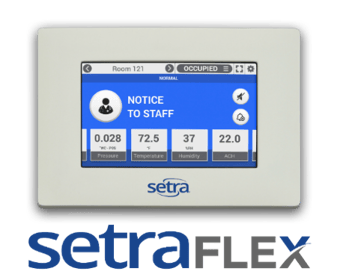Maintaining and monitoring room pressurization in hospitals is essential for meeting regulatory standards and ensuring the safety of a space. Incorrect room pressurization jeopardizes the health of both patients and staff.
Monitor Pressure with a DPT
Differential pressure transducers (DPTs) are commonly used to measure room pressurization in hospital spaces. A DPT is designed to measure the pressure between two spaces, like a hospital room and the hallway. DPTs are particularly useful if a space has multiple entrances, as they can provide additional pressure readings at each door. However, DPTs cannot replace a fully-fledged environmental room monitor. DPTs have neither audible nor visual alarms, nor do they have large, interactive displays where users can immediately see information on any deviations from compliance.
Comprehensive Monitoring with an RPM
Room pressure monitors (RPMs) are the ideal solution for monitoring hospital spaces, especially when looking to monitor multiple parameters from a single point. In addition to differential pressure, an RPM can display data for a number of other sensors, including:
- Door switches
- Temperature and humidity
- Particle counts
- Velocity
With the need to monitor a variety of parameters in a single hospital space, it is important to aggregate the data in one place, like on the screen of an RPM. A singular location for the data reduces the risk of data being overlooked. RPMs also have audible and visual alarms, which are crucial for maintaining safety. The ability to alarm, combined with a display screen, makes RPMs more conducive to monitoring a hospital tan a DPT on its own.
Meet Safety Standards with Setra FLEX
As an environmental monitor, FLEX does more than just measure differential pressure; when connected to other sensors in the space, FLEX becomes a hub for information and control. Setra FLEX also ties back to a BMS so the room can be monitored from anywhere in a hospital. FLEX’s alarming capabilities, large display, and flexibility to configure inputs from either the touch screen or over BACnet make it adaptable to meet any needs. An environmental monitor like FLEX makes the management of differential pressure transducers visual and intuitive.


